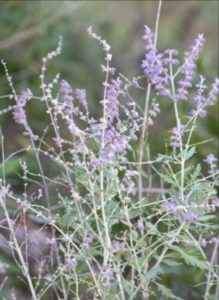

by Lydia Holley November 2, 2020
Russian sage is another plant which has recently changed its name, from Perovskia atriplicifolia to Salvia yangii, officially putting it in the sage genus. It is called Russian sage because Perovskia was named for a Russian general, not because it is from that area. Russian sage is actually from Asia, so a common name such as Tibetan sage would have been more appropriate.
Russian sage is woody on the bottom, but its blooms are airy on top, so it is best planted in masses. One source says this plant will multiply by spreading underground, and being in the mint family, that would make sense, but that has not yet been my experience.
This plant loves Texas because it appreciates heat, sun, and dry soil conditions. If you have been looking for something that can take our extreme summer temperatures, you have found it. You do not have to worry about cold snaps, either, as this plant grows in zones 4 through 9. It appreciates full sun, and can grow in either acidic or alkaline soils, whether the soil is poor or fertile. It is also deer resistant.
There are several cultivars of Russian sage, some which grow to five foot tall while others stay as low as two feet. It can grow in the ground or in containers. Because of its rangy look, it is best added to informal garden settings.
A deciduous subshrub, Russian sage will lose its leaves in winter. To keep it from flopping, you can prune it in spring to around one foot tall. Or you can place it in your garden alongside other plants which will give it some support. Perhaps the best solution is to embrace its natural form and let it flop toward plants which complement its color and style.
For more information, call 903-675-6130, email hendersonCMGA@gmail.com.
Follow us on Facebook: https://www.facebook.com/HCmastergardener.